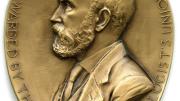William Brewster was too frail, his eyesight too poor, said his parents and doctors, for him to attend Harvard. Instead, early each morning, he pulled on his boots and spent whole days tramping through woods, fields, and marshes in search of birds near his family home, a small estate on Brattle Street in Cambridge. He became an earnest observer of birds and their habits when he was about 10, beginning the careful records he maintained throughout his life. His father had given him a gun and taught him to shoot: in the 1860s, the accepted—indeed, the only—way to observe and study birds. Binoculars as we know them were not available in Brewster’s lifetime; not until his last years did he have “field glasses.” But his hearing was acute, and he listened to birds’ songs until he learned them, becoming able to identify birds without having to depend on his gun.
From boyhood, his best friend was Daniel Chester French, the future sculptor. French’s father taught both boys how to stuff birds and Brewster, while still in his teens, had cases filled with his specimens. His own father encouraged him with a gift of the five volumes of Audubon’s Ornithological Biography, which included notes on bird behavior and anatomical details. At first, Brewster and three friends met in his attic to study these precious books. In 1873, they invited six other young naturalists to form the Nuttall Ornithological Club, named for former Harvard botanist Thomas Nuttall, author of the first “field guide” to birds (1832), a small volume just the size to fit in Brewster’s pocket. The club flourished for years, and issued regular bulletins.
After his marriage, Brewster built a new house on the site of his family home and, at the back of the garden, a brick library and museum to hold his growing collection of mounted birds. Drawing on his voluminous journals and letters (now in the archives of Harvard’s Museum of Comparative Zoology [MCZ]), he wrote Birds of the Cambridge Region, published in 1906. He describes the haunts of his youth and mourns changes in the Cambridge landscape: “swamps and meadows drained or filled, and woods, groves, thickets, and orchards swept away…,” and the “reclaiming—or, as some of us prefer to characterize it, destroying [of]—the Charles River Marshes, these once primitive and beautiful salt meadows.”
He had also begun to observe a gradual decline in the numbers and abundance of local bird species. In 1869, he observed a flock of 50 passenger pigeons heading south—even then a rarity, though elderly sportsmen recalled great clouds of them overhead and hunters bringing down dozens at a time for sale in Boston. In 1875, in the interest of science, Brewster himself shot “a fine adult male” for his museum. “It was the last Pigeon I have seen, or am likely to see, alive in the Cambridge region,” he wrote in 1906. The disappearance of the species was, he realized, “due chiefly or wholly to systematic persecution on the part of man.” He came to lament the slaughter of once common birds for sport or the market: “…there was much shooting on the meadows over which the snipe were drumming last evening and I fear that some of the poor birds fell victims. It is a shame that our laws should allow this spring shooting of a bird which is so rapidly decreasing.” Eventually he gave up shooting entirely, and did not allow it on his property.
The environmental changes Brewster witnessed impelled him toward an active role in preservation. Protecting birds meant protecting their habitat, as well as limiting hunting and discouraging the use of feathers on women’s hats. He had often explored Concord with his friend French, and in 1890 purchased Davis Hill, on the Concord River, to save the old trees from a developer’s axe. He later bought adjacent land and an old farmhouse. He canoed in all seasons, carved trails through his woods, and built a log cabin near the water where he stayed with naturalist friends.
He also observed the world around him and wrote of it simply and directly in prose reflecting sensitivity and restrained emotion rather than cold scientific detachment. One fall day, as “rain came down in perfect sheets and the east wind roared through the treetops,” he spent two hours in the woods, “curious to see what wild creatures were out in such a storm.” One summer sunset on the river, he noted the bird songs and the frogs and watched a cloud resembling a mountain, “…one end breaking down abruptly in a precipice…, the whole…tinged salmon and ashes of roses and strongly luminous as if the sun were shining through it from beyond.”
Bird migration intrigued him. The night sky might be “alive with birds” traveling south, as “may be learned by anyone having keen hearing who will take the trouble to stand for a few hours on some elevated spot and listen intently.” He spent seven weeks in a lighthouse on the Bay of Fundy, observing how migrants, confused by the light, flew into it, so that on foggy nights “it fairly rained birds.” Once he counted warblers of seven species dead on the rock.
From 1885 until he died, Brewster oversaw the bird collection at the MCZ, where his own collection, the finest in the country, came to rest. (Harvard awarded him an honorary master’s in 1889.) In 1896 he became the first president of the fledgling Massachusetts Audubon Society. After his death, more of his notes were gathered together in October Farm and Concord River. Ironically, despite the poor eyesight that kept him out of college, his great contributions depended on his powers of observation.
Alan Emmet ’50 is the author of So Fine a Prospect: Historic New England Gardens. She also writes for House & Garden.






